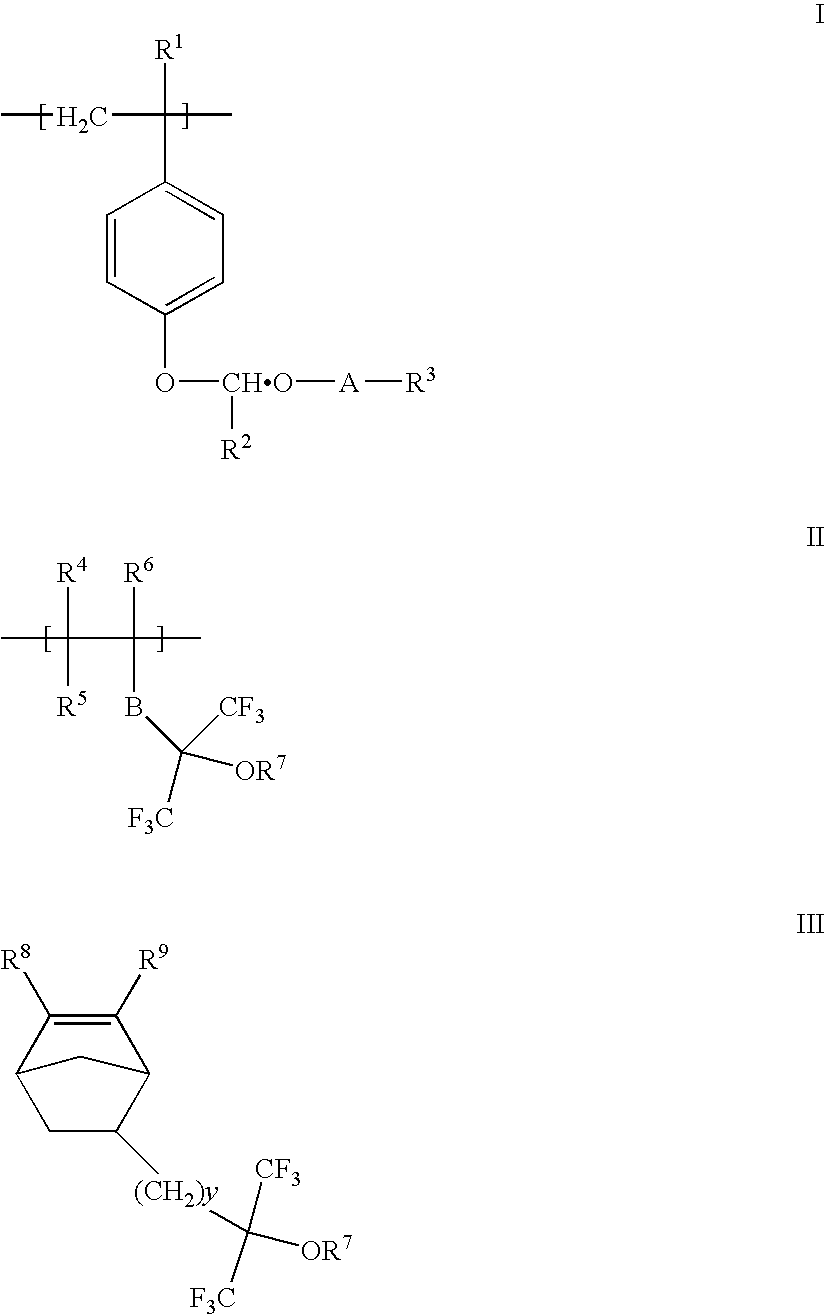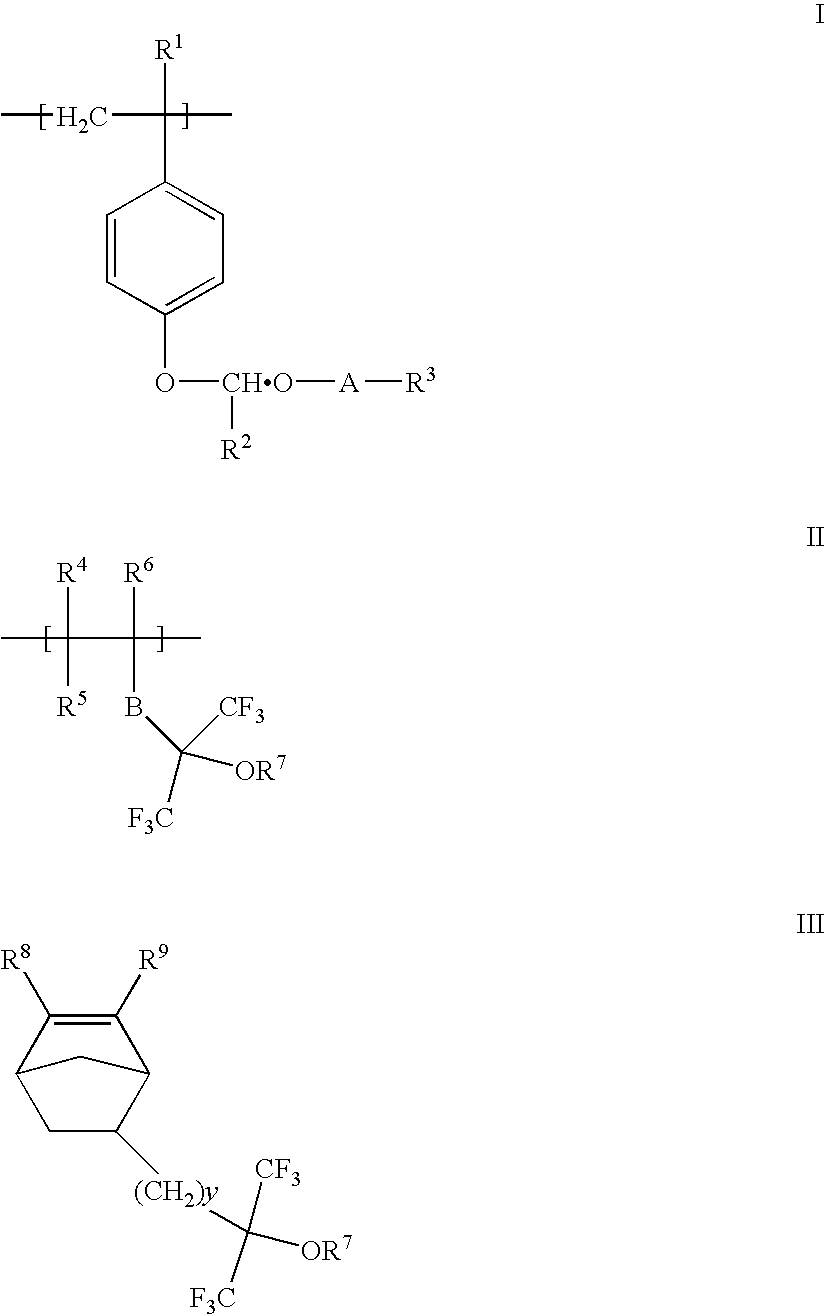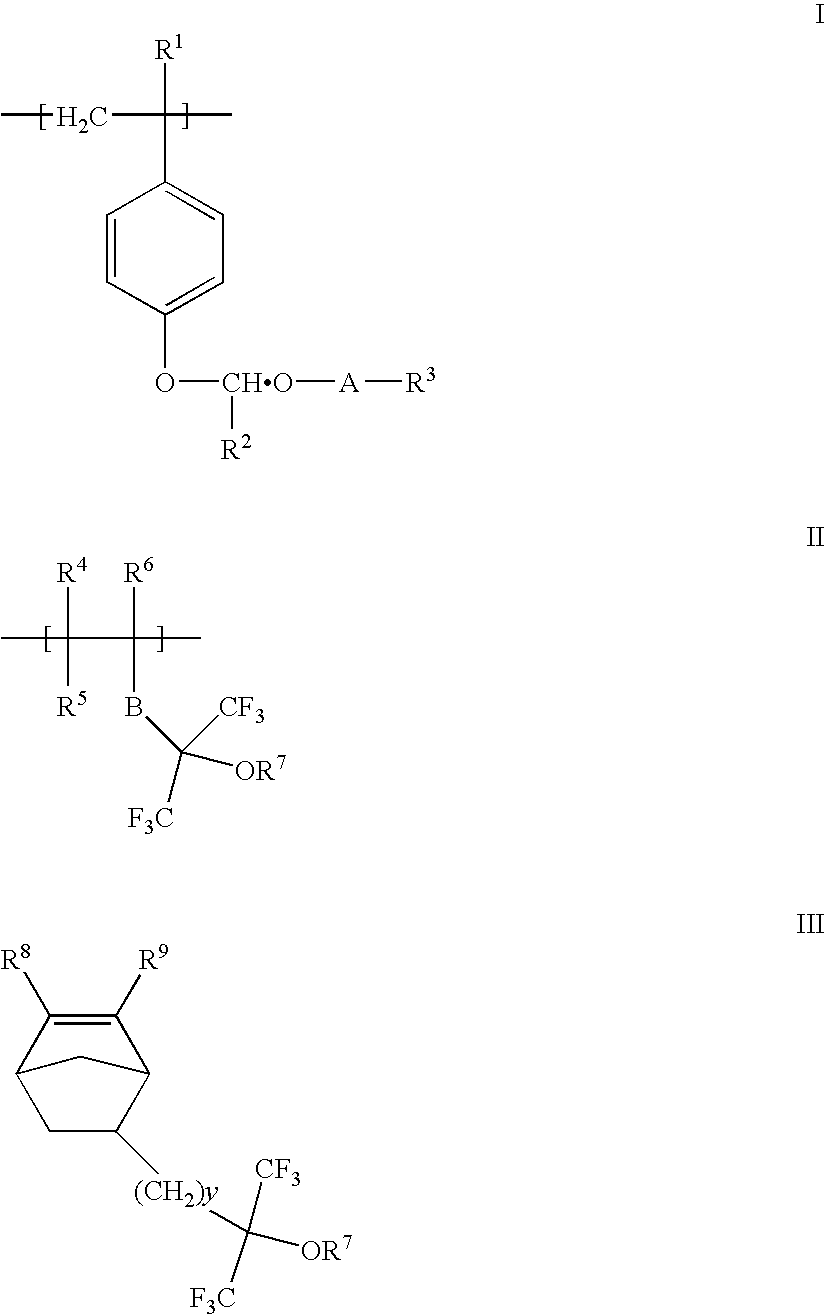Acetal protected polymers and photoresists compositions thereof
a technology of acetal protected polymers and compositions, applied in the field of acetal protected polymers and photoresisting compositions thereof, can solve the problem of unacceptably high optical density of film thicknesses
- Summary
- Abstract
- Description
- Claims
- Application Information
AI Technical Summary
Benefits of technology
Problems solved by technology
Method used
Image
Examples
synthesis example 2
Preparation of Acetal Blocked SE-1 (SE-2): Prepared by Reaction Between SE-1 and t-butyl vinyl ether and 3,3,4,4,5,5,6,6,7,7,8,8,8-tridecafluoro-1-octanol
Into a 100-mL three-neck round-bottom flask equipped with a magnetic stir bar, a thermocouple, a glass stopper and a rubber septum was charged 4.98 g of poly(4-hexafluoroisopropylstyrene-co-4-hydroxystyrene) (SE-1) and 29.27 g of ethyl acetate (EtOAc). The solution was vacuum distilled at 60.degree. C. until 8.40 g of solvent was removed. To 25.85 g of the remaining polymer solution 2.20 g 3,3,4,4,5,5,6,6,7,7,8,8,8-tridecafluoro-1-octanol (FOH) and 0.71 g tertiary butyl vinyl ether (tBVE) were added. The reaction was catalyzed with 0.30 g pTSA solution (prepared as 0.003 g of pTSA dissolved in 0.297 g of EtOAc). At 4 h the reaction was quenched with 1.45 g of CR-20 resin and stirred for 20 minutes. The polymer solution was filtered and precipitated in 300 mL of hexanes and washed three times each with 50 mL of hexanes. The polymer ...
synthesis example 3
Preparation of Acetal Blocked SE-1 (SE-3): Prepared by Reaction Between SE-1 and t-butyl vinyl ether and 2,2,3,3-tetrafluoro-1-propanol
Into a 100-mL round-bottom flask was charged 5.0 g of poly(4-hexafluoroisopropyl styrene-co-4-hydroxystyrene) (SE-1) and 20.0 g of EtOAc. The solution was concentrated using a rotary evaporator at 40.degree. C. until 7.9 g of solvent was removed. The flask was equipped with a magnetic stir bar and a thermocouple. To 17.1 g of the remaining polymer solution 1.6 g of 2,2,3,3-tetrafluoropropanol (TFP) and 1.2 g of tBVE were added. The reaction was catalyzed with 0.03 g of pTSA solution (prepared as 0.0003 g pTSA dissolved in 0.0297 g EtOAc) and stirred for 24 h. The reaction was quenched with 1.0 g of CR-20 resin and stirred for 20 minutes. The polymer solution was filtered and precipitated in 100 mL of hexanes. The polymer solid was filtered and dried in a vacuum oven at 60.degree. C. for 12 h. Analytical data is included in the table below.
synthesis example 4
Preparation of Acetal Blocked SE-1(SE-4): Prepared by Reaction Between SE-1 and t-butyl vinyl ether and 3-heptamethylcyclotetrasiloxane-1-propanol
Into a 50-mL round-bottom flask was charged 1.0 g of poly(4-hexafluoroisopropyl styrene-co-4-hydroxystyrene) (SE-1), 9.38 g of EtOAc and 0.39 g of 3-heptamethylcyclotetrasiloxane-1-propanol (HMTP). The solution was rotovapped at 30.degree. C. until 8.15 g of solvent was removed. This process was repeated with 6.80 g of additional EtOAc added and 5.84 g solvent removed. The flask was equipped with a magnetic stir bar and a thermocouple. To 3.58 g of the remaining polymer solution 2.42 g of EtOAc and 0.13 g of tBVE were added. The reaction was catalyzed with 0.01 g of camphorsulfonic acid (CSA) solution (prepared as 0.0001 g CSA dissolved in 0.0099 g EtOAc). At 4.5 h the reaction was quenched with 0.50 g of triethylamine (TEA) solution (prepared as 0.005 g TEA dissolved in 0.495 g EtOAc) and stirred for 15 minutes. The polymer solution was f...
PUM
| Property | Measurement | Unit |
|---|---|---|
| thickness | aaaaa | aaaaa |
| temperature | aaaaa | aaaaa |
| temperatures | aaaaa | aaaaa |
Abstract
Description
Claims
Application Information
 Login to View More
Login to View More - R&D
- Intellectual Property
- Life Sciences
- Materials
- Tech Scout
- Unparalleled Data Quality
- Higher Quality Content
- 60% Fewer Hallucinations
Browse by: Latest US Patents, China's latest patents, Technical Efficacy Thesaurus, Application Domain, Technology Topic, Popular Technical Reports.
© 2025 PatSnap. All rights reserved.Legal|Privacy policy|Modern Slavery Act Transparency Statement|Sitemap|About US| Contact US: help@patsnap.com



